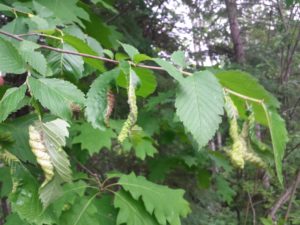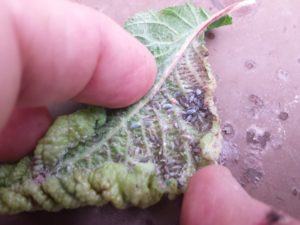
Woolly elm aphid damage on leaves.
Feeding by woolly elm aphids has become apparent this summer, with light to moderate, but non-threatening levels of foliar damage on American elm. Woolly elm aphids are just one species among a specialized group of native aphids called woolly aphids.
Learn about the woolly alder aphid in this month’s northeast forest health article.
Woolly aphids are sucking insects that feed on leaves, buds, twigs, bark, and roots, but rarely cause significant injury to mature trees. Feeding causes leaves to curl inward, become bumpy, and develop necrotic brown and yellow blotches. A cottony mass of pear-shaped aphids with waxy, white stands can be observed under damaged leaves. Honeydew secretions from aphid sap feeding can promote sooty mold growth on leaves, but causes little injury.

Woolly elm aphids on underside of leaf.
Woolly aphids produce a waxy white covering, giving them a “woolly” appearance and providing a protective barrier from predators. Having a complex life cycle, most woolly aphids produce multiple clonal generations each year and use two different host plant species, which vary by the particular species of woolly aphid. Woolly elm aphid uses American elm and serviceberry as its host species. In early summer, after two generations of female-only clones are produced—each living and feeding for about 1 month—some winged females from the second generation fly to serviceberry where they produce yet another generation of female-only clones that then migrate down to the serviceberry roots to form a root colony. In early fall, after two more clonal generations of females are produced, some fourth generation winged females emerge from the root colonies and fly back to elm, where they produce a blended generation of both male and females that then mate. The mated females lay one overwintering egg in a bark crack and die, completing the life cycle.
Written by Paul Cigan, forest health specialist, Hayward (Paul.Cigan@Wisconsin.gov), 715-416-4920.
